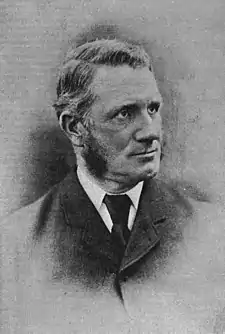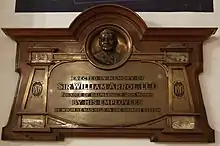William Arrol
Sir William Arrol (13 February 1839 – 20 February 1913) was a Scottish civil engineer, bridge builder, and Liberal Unionist Party politician.



Career
The son of a spinner, Arrol was born in Houston, Renfrewshire, and started work in a cotton mill at only 9 years of age. He started training as a blacksmith by age 13, and went on to learn mechanics and hydraulics at night school. In 1863 he joined a company of bridge manufacturers in Glasgow, but by 1872 he had established his own business, the Dalmarnock Iron Works, in the east end of the city.[1] The business evolved to become Sir William Arrol & Co., a large international civil engineering business.[1]
Projects undertaken by the business under his leadership included the replacement for the Tay Bridge (completed in 1887), the Forth Bridge (completed in 1890) and Tower Bridge (completed in 1894).[1] He was also contracted by the Harland and Wolff Shipyard, Belfast, to construct a large gantry (known as the Arrol Gantry) for the construction of three new super-liners, one of which was called the RMS Titanic.[2]
Arrol was knighted in 1890,[1] and elected as the Liberal Unionist Member of Parliament (MP) for South Ayrshire at the 1895 general election, serving the constituency until 1906.[3] He served as President of The Institution of Engineers and Shipbuilders in Scotland from 1895–97. He spent the latter years of his life on his estate at Seafield House, near Ayr,[4] where he died on 20 February 1913.[1] He is buried in Woodside Cemetery, Paisley, on the north side of the main-east west path on the crest of the hill.[5]
Legacy
In 2013 he was one of four inductees to the Scottish Engineering Hall of Fame.[6] His image is also featured on the Clydesdale Bank £5 note introduced in 2015.[7]
See also
References
- "Sir William Arrol". Scottish Gazetteer. Retrieved 7 February 2020.
- "The giant Arrol Gantry". National Museums Northern Ireland. Retrieved 16 October 2019.
- "Sir William Arrol". UK Parliament. Retrieved 7 February 2020.
- "Seafield Children's Hospital". Historic Hospitals. 26 April 2015. Retrieved 7 February 2020.
- "Heritage Trail". Paisley Cemetery. Retrieved 7 February 2020.
- "Sir William Arrol (1839–1913)". Scottish Engineering Hall of Fame. Retrieved 16 October 2019.
- "Clydesdale Bank brings in plastic £5 notes". BBC News. 23 March 2015. Retrieved 18 June 2016.
Further reading
- Peter R. Lewis, Beautiful Railway Bridge of the Silvery Tay: Reinvestigating the Tay Bridge Disaster of 1879, Tempus, 2004, ISBN 0-7524-3160-9.
- Charles McKean Battle for the North: The Tay and Forth bridges and the 19th century railway wars Granta, 2006, ISBN 1-86207-852-1
- John Rapley, Thomas Bouch : the builder of the Tay Bridge, Stroud : Tempus, 2006, ISBN 0-7524-3695-3
- PR Lewis, Disaster on the Dee: Robert Stephenson's Nemesis of 1847, Tempus Publishing (2007) ISBN 978-0-7524-4266-2
- Sir Robert Purvis, Sir William Arrol a Memoir, London, 1913
External links
- Sir William Arrol: History and legacy of the pioneering Scottish Engineer.
- Hansard 1803–2005: contributions in Parliament by William Arrol